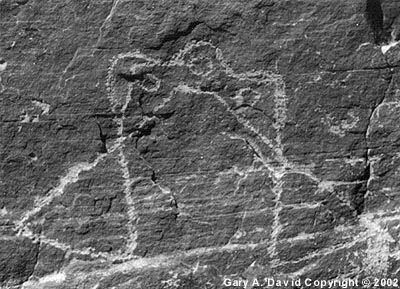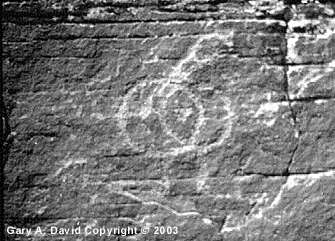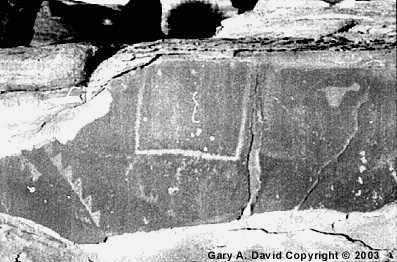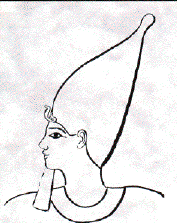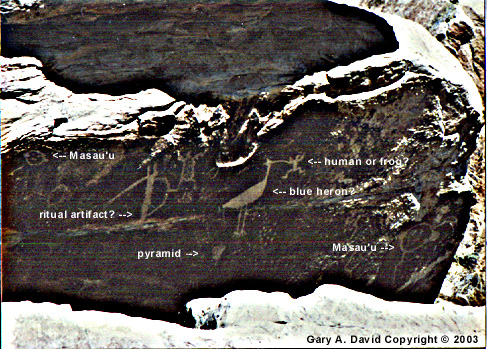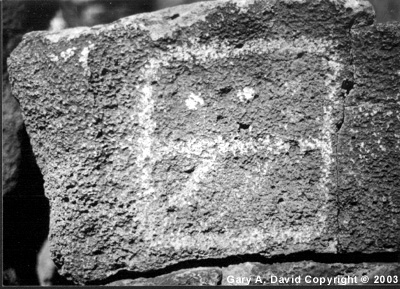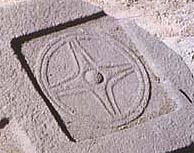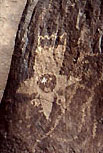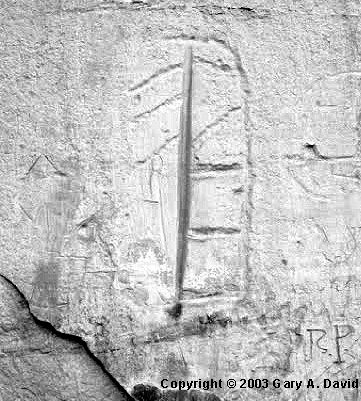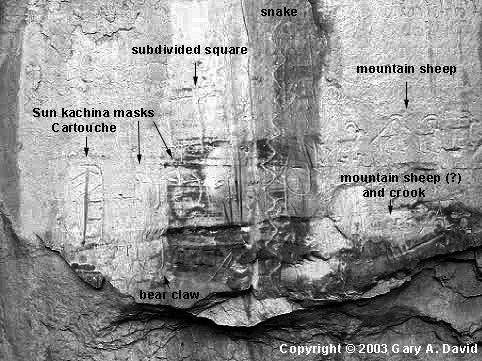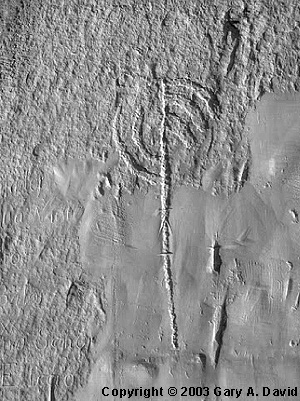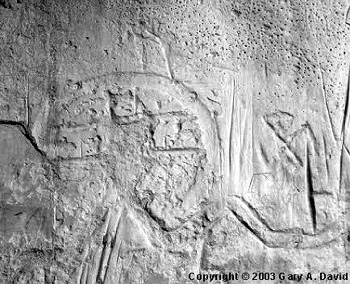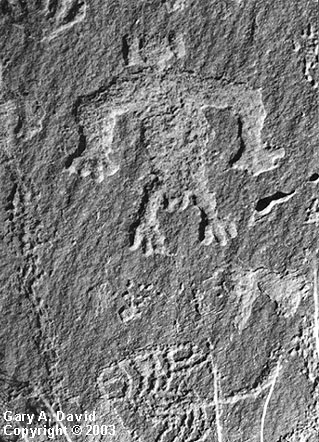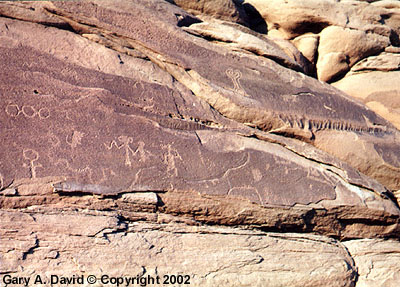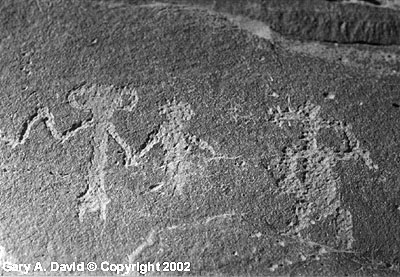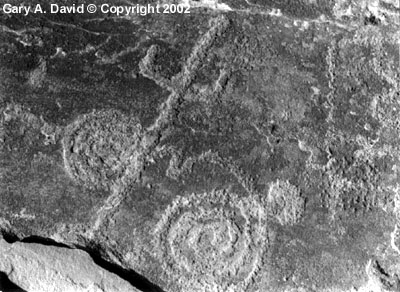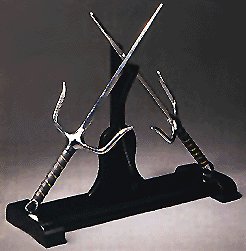Petroglyph Anomalies of the American Southwest
(Please
be patient while graphics are loading.)
by
Gary A. David
Copyright
© 2002 by Gary A. David.
All rights reserved. No photos may be used without permission.
|
|
|
Homolovi
State Park near Winslow, Arizona
|
Is
this the depiction of a triangular aerial craft, a version of the Hopi paatuwvota,
or "flying
shield"?
|
|
|
Vesica
Piscis, Homol'ovi IV, near Winslow, Arizona
|
|
|
|
Cottonwood Creek Ruin near Winslow, Arizona
|
White
Crown of Upper Egypt
|
Is
the figure on the right an Egyptian hedjet crown (front toward bottom),
or is this just a coincidence?
|
|
|
Petrified
Forest National Park, Arizona
|
Is
this a blue heron stabbing a human? Note the pyramid shape below and to the left.
Compare this with the phoenix sitting atop the benben
stone at Heliopolis in Egypt.
|
|
|
Perry
Mesa, Agua Fria National Monument, Arizona
|
Is
this petroglyph symbolic of Orion, with the upper portion representing the belt
stars and the lower portion the sword?
|
|
|
|
Symbol
of Baal on offering table
c. 1300 BC
Hazor, Canaan (Israel)
|
Star
with bird feet and tail, c. 1300 AD Petroglyph National Monument, New
Mexico
|
Baal
was the Phoenican god of rain, thunder, and lightning. Joshua burned down the
city of Hazor, "the
head of all those kingdoms," c. 1200 BCE. (Joshua 11: 10-13)
The petroglyph to the right may represent the eye of Sotuknang, the ancient
Hopi sky god.
PRELIMARY
INVESTIGATION OF OGAM
AT EL MORRO NATIONAL MONUMENT, NEW MEXICO
Go
to National Parks Service web page re. El
Morro National Monument in northwestern New Mexico. This is a major petroglyph
site of both the prehistoric and the historic periods. (Read another article.)
"Ogam
[or Ogham] is an alphabet, not a language, and it was used to render the Old
Irish, the Pictish, the old Gaelic of Scotland and some other dialects such
as Icelandic or Old Norse of the Shetlands and Orkneys, chiefly on tombstones
but also occasionally in manuscripts and engraved brooches." Dr. Barry
Fell ["A Response to Criticism: An Interview with Barry Fell," Marshall
Payn, Exploring Rock Art, edited by Donald L. Cyr (Santa Barbara, California:
Stonehenge Viewpoint, 1989, 1986), p. 78]
|
|
|
Ogam
(?) surrounded by Egyptian-style cartouche,
El Morro National Monument, New Mexico
|
Any
ogam experts out there? Please let us know if you have any ideas what this might
mean. Email Gary David, Thank
you. The inverted "V" glyph to the left may be the Egyptian determinative
for "to walk." (E.A.Wallis Budge, Egyptian Language: Early Lessons
in Egyptian Hieroglyphics (New York: Dover Publications, Inc., 1983, reprint
1910), p. 34.]
|
|
|
Larger
view of panel with ogam to the left
|
This
vertical stemmed ogam possibly spells F-D (marks
on the right represent F, marks
on left represent D). Old ogam (800-300 BC) lacks vowels, so this word is actually
fad, meaning "distance." [Source:
Barry Fell, America B.C. Ancient Settlers in the New World (New York: Demeter
Press, 1977, 1976) p. 194.] Has the actual distance number been rubbed out for
some reason? Script at lower left of photo may be signatures of emigrants, but
further research is needed to establish this.
|
|
|
Sun
shield, swastika, and possible ogam letter
with snake superimposed
|
On lower right within curve of snake (or water glyph), the
shorter horizontal line attached to the
vertical line may designate M, or the Celtic term
Mo, which means "elder, senior." [Source: Fell, ibid.,
p. 52, pp. 194-5]
|
|
|
Petroglyph
of female, Homolovi State Park
|
This petroglyph near Winslow, Arizona carved
probably about the late thirteenth century shows a female with poli’ini,
or butterfly hair whorls (sometimes misdesignated as
squash blossoms) on each side of her head. This photo link to the Cline Library
Image Database at Northern Arizona University shows an early twentieth century
young Hopi
maiden from the First Mesa village of Sichomovi with the same characteristic
hair style. These hair whorls or disks were sometimes represented by the Maltese
cross, a symbol of fertility or virginity. (Both whorls from each side of the
head are laid across each other at right angles to form the cross.) Of course,
the Maltese cross
is a Knights Templar emblem. In Mexico it is known as the Cross of Quetzalcoatl.
It also occurs on pottery from the fourth millennium found at Susa, the capital
of Elam (the biblical Shushan in present-day western Iran).
|
|
Petroglyph
at Cottonwood Creek Ruin near Winslow, Arizona
(See article titled "Mystery Mesa"
on this Web site.)
|
At the far left is the alchemical symbol of Venus. Above
that are three circles connected by two horizontal straight lines. In his book
The Rocks Begin to Speak, LeVan Martineau (Las Vegas: KC Publications,
Inc. 1994,1973) states that two circles connected
by a line signifies communication. Perhaps three circles suggest communication
between the three figures to the right. Martineau also believes that zoomorphs
do not necessarily represent horned
animals but may instead connote direction. In this case the horns on the animal
are pointed downward toward the snake. Does this mean that the three figures made
a journey to the Underworld or spirit world?
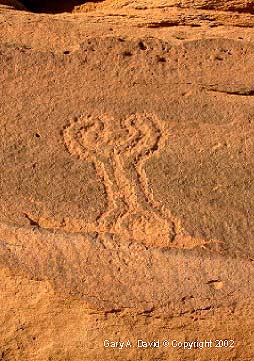 |
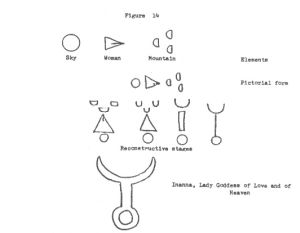
from
a 1989 article by Dr. Ali Akbar Bushiri
of Bahrain University,
published in Volume 18 of ESOP
(Epigraphic Society Occasional Publications)
|
|
Crescent
on a vertical staff
with a circle or crescent at the bottom
|
|
The fact that
this petroglyph (left) appears on the top of the same panel that has a Venus alchemical
symbol reinforces the notion that this icon represents Inanna, goddess of fertility
and love in Sumer and Dilmun (or Tilmun, now called Bahrain). Note what appears
to be a triad of three natural holes above and slightly to the right of the petroglyph.
Although inverted from the usual position shown in Dr. Bushiri's work (right)
to represent "mountain," this triangle of holes may mean the same thing.
|
|
|
. The
ET-like figure on the left is possibly Masau’u, Hopi god of death and
the Underworld, holding hands with a human. The figure on the right may
be a Soyoko (Ogre) Katsina, who has a snout with sharp teeth and a baton
or bow in his left hand. This along with the Hu (Giant) Katsina found
in Hopi cosmology point to the possibility that "giants in the earth"
(Genesis 6:4) roamed northern Arizona.
|
|
|
|
|
Petroglyph
of spirals and three-pronged truncheon
Homolovi State Park, Arizona
|
The
sai
origianted
in Japan
but was also used in China.
|
Although
the
recent Hollywood movie "The Mummy Returns" shows
two scantily clad female combatants of ancient Egypt using
trident-like truncheons,
this weapon is actually of Japanese origin. The sai is a blunt martial
arts weapon used to deflect swords but may have developed from a farming implement
employed to make furrows.
This petroglyph from northern Arizona shows the spiral on the left touching the
instrument, its power continuing across the line to the spiral on the right. In
rock writing the spiral represents a whirlpool or whirlwind but it also signifies
a portal, vortex or interdimensional space of numinous influence. A
counterclockwise spiral refers to descending movement while a clockwise spiral
means ascension. Perhaps the spiral on the left energizes the instrument whose
origin is the Underworld. On the right-hand side the line of force dips (energy
pauses?) before rising to the Earth's surface (the carved circle touching the
arc at about a two o'clock position).
For more on a possible Japanese-American Indian connection, see The Zuni Enigma
by Nancy Yaw Davis (New York: W.W. Norton & Company, 2000).

